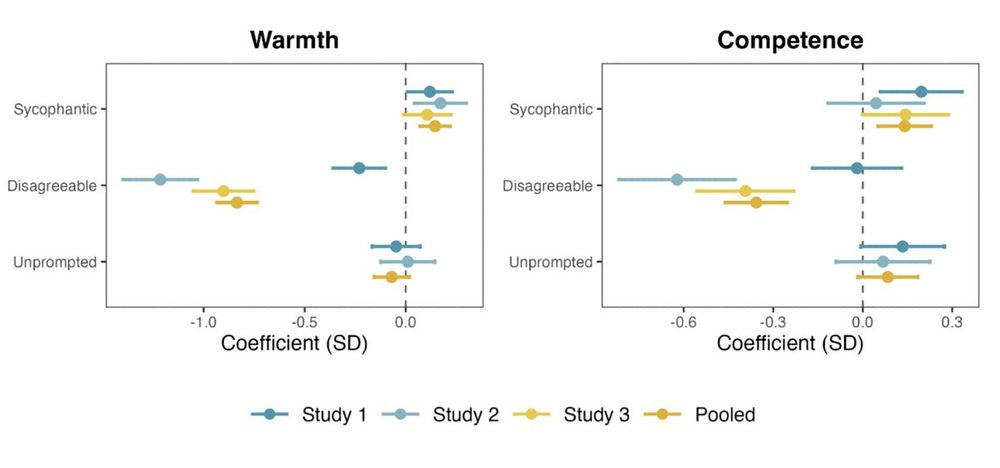🎥 Watch here on YouTube: www.youtube.com/watch?v=TFm3...
🎧 Listen on Spotify: open.spotify.com/episode/0Oi6...
🎥 Watch here on YouTube: www.youtube.com/watch?v=TFm3...
🎧 Listen on Spotify: open.spotify.com/episode/0Oi6...
is on the front cover of this month's issue of
@cp-trendscognsci.bsky.social.

is on the front cover of this month's issue of
@cp-trendscognsci.bsky.social.
In other words, AI sycophancy might lead to inflated self-perceptions.

In other words, AI sycophancy might lead to inflated self-perceptions.
However, sycophantic AI was rated by participants as both warmer *and* more competent.

However, sycophantic AI was rated by participants as both warmer *and* more competent.
In reality, *both* chatbots were biased: the sycophantic chatbot was simply biased in the user’s favor.

In reality, *both* chatbots were biased: the sycophantic chatbot was simply biased in the user’s favor.

-The sycophantic chatbot led to more extreme & certain beliefs
-The disagreeable chatbot led to less extreme & certain beliefs
-The off-the-shelf model had no impact on belief extremity

-The sycophantic chatbot led to more extreme & certain beliefs
-The disagreeable chatbot led to less extreme & certain beliefs
-The off-the-shelf model had no impact on belief extremity
Across 3 experiments (n = 3,285), we found that interacting with sycophantic (or overly agreeable) AI chatbots entrenched attitudes and led to inflated self-perceptions.
Yet, people preferred sycophantic chatbots and viewed them as unbiased!
osf.io/preprints/ps...
Thread 🧵

Across 3 experiments (n = 3,285), we found that interacting with sycophantic (or overly agreeable) AI chatbots entrenched attitudes and led to inflated self-perceptions.
Yet, people preferred sycophantic chatbots and viewed them as unbiased!
osf.io/preprints/ps...
Thread 🧵




The information-as-virus metaphor can be extended even further:

The information-as-virus metaphor can be extended even further:
Why do some ideas spread widely, while others fail to catch on?
We review the “psychology of virality,” or the psychological & structural factors that shape information spread online and offline: authors.elsevier.com/c/1lRke4sIRv...

Why do some ideas spread widely, while others fail to catch on?
We review the “psychology of virality,” or the psychological & structural factors that shape information spread online and offline: authors.elsevier.com/c/1lRke4sIRv...

www.forbes.com/30-under-30/...

www.forbes.com/30-under-30/...

People engage with divisive and negative content online. But, does this mean that people *like* divisive content? No! We find that people across the political spectrum do not want divisive content to spread.
journals.sagepub.com/doi/10.1177/...

People engage with divisive and negative content online. But, does this mean that people *like* divisive content? No! We find that people across the political spectrum do not want divisive content to spread.
journals.sagepub.com/doi/10.1177/...

